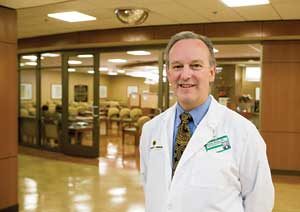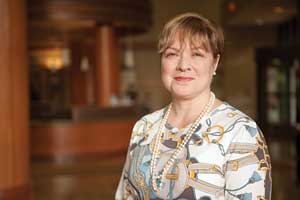From Good to Great
Quality in Cancer Care
March 21, 2012 | Dagny Stuart
 “You have cancer” are three of the most difficult words any patient will ever hear. A diagnosis of cancer sends patients into a bewildering, emotion-laden world filled with unusual tests, unpronounceable medical terms, and the need to make a number of decisions, including where to get care and how to ensure that the care is of the best possible quality.
“You have cancer” are three of the most difficult words any patient will ever hear. A diagnosis of cancer sends patients into a bewildering, emotion-laden world filled with unusual tests, unpronounceable medical terms, and the need to make a number of decisions, including where to get care and how to ensure that the care is of the best possible quality.
But when it comes to health care – and cancer care, in particular – the subject of “quality” can seem nebulous. What is quality care? Who defines it? How do we measure quality? And how do patients know if they are receiving high quality care?
When it comes to “quality” in medicine, “it’s hard to argue that outcomes trump everything else and that survival is the most important outcome,” explained Michael Neuss, M.D., Chief Medical Officer with Vanderbilt-Ingram Cancer Center, quoting Dr. Avedis Donabedian, a University of Michigan professor known as the Father of Quality in health care.
“In the hierarchy of quality, Donabedian said survival comes first, functional status next, and a patient’s happiness with their care comes after that. I think he’s right and the government, in the Affordable Care Act, has said that patient satisfaction is an important quality measure. That seems legitimate, and while we’re most interested in helping people beat cancer, we are aware that we have to do everything possible to make the journey safe and as pleasant as possible,” said Neuss.
But viewpoints on defining quality differ. And oncologists and other cancer specialists are facing their own questions about how to deliver superior care as government agencies and professional medical organizations place an increasing emphasis on standards of quality.
“Quality of care should be more than just receiving the cutting-edge technology at a tertiary care institution,” said Mohana Karlekar, M.D., medical director of Vanderbilt’s Palliative Care Program. “(Quality) is about being heard.”
The Right Treatment
“First, do no harm,” one of the tenets of ancient Greek medicine, is a concept so ingrained in modern health care that it has been added to the professional ethical standards for physicians. The idea that physicians must consider all of the ramifications of their decisions and actions is central to the informed practice of medicine.
Today, health care is delivered not just by physicians but by multidisciplinary teams of health care professionals, all interacting with patients and providing expertise in their medical specialties. The addition of all of these specialists to the patient’s care team provides a new level of expertise and certainly improves treatment outcomes. But it also increases the number of decisions that must be made every day about what to do – or not do – during the treatment process.
All of those decisions, and the outcomes they influence, contribute to quality of care.

Michael Neuss, M.D., Chief Medical Officer at Vanderbilt-Ingram, is involved in national efforts to improve quality in cancer care. (Photo by Rusty Russell)
Cancer patients are clearly benefiting from new technologies and treatments that focus on survival. There are now at least 12 million cancer survivors in the United States, according to the Centers for Disease Control and Prevention. That compares to 9.8 million in 2001 and just 3 million in 1971.
The question for physicians and researchers is whether there would be even more cancer survivors who still function well if all patients received the same high standard of care.
“I have seen people who were egregiously mistreated and they get very angry about that when they eventually come to a center like Vanderbilt and recognize that we are doing something different or that their original treatment was not appropriate,” said Barbara Murphy, M.D., director of Vanderbilt-Ingram’s Cancer Supportive Care Program. “Patients really want to think that their doctors are doing the right thing and won’t make poor treatment decisions.”
Murphy said most community-based oncologists are providing an excellent level of care but they face the same issues as cancer specialists at academic medical centers – how to determine the best therapies for optimal treatment and how to standardize care so that patients can be assured that they are receiving the best available care no matter where they are treated. This is a particular challenge for patients with uncommon cancers or who require highly specialized care.
In cancer care, oncologists tend to focus on process-based measures, according to Neuss, who is a founding member of the American Society of Clinical Oncology’s Quality Oncology Practice Initiative (QOPI), a program to help physicians integrate continuous quality improvement into patient-centered clinical practice.
“This means that you see a patient with breast cancer and get the right pieces of information about that patient’s disease and then formulate a therapeutic plan which is specific to the individual patient and the characteristics of their disease,” said Neuss. “As we learn more, it’s getting more difficult to understand each piece of information and how it ranks in the ‘paper, scissors, rock’ hierarchy of importance.”
The medical community is working to ensure that physicians know about the latest research on effective treatments and that they adhere to those standards.
Vanderbilt-Ingram is on the front lines of this quality initiative as a member of the National Comprehensive Cancer Network (NCCN), a nonprofit alliance of 21 of the world’s leading cancer centers dedicated to improving the quality and effectiveness of care for cancer patients. NCCN is creating clinical practice guidelines for physicians to help them make informed choices about how to treat specific forms of cancer.
In today’s world of increasingly personalized medicine, determining that a patient has cancer in a specific organ is just the beginning of the quest for relevant information that could influence treatment decisions.
The discovery that not all cancers are the same and that some tumors may have different genetic mutations is dramatically changing the concept of how to treat cancer patients appropriately. Based on this genetic information, breast cancer patients now receive specific therapies if their tumors are positive for the HER2 protein, melanoma patients will be given a newly approved drug if their tumor has the BRAF gene mutation, and lung cancer patients with an ALK fusion mutation in their tumor will be matched to another novel drug.

Mohana Karlekar, M.D., medical director of Vanderbilt’s Palliative Care Program. (Photo by Daniel Dubois)
Some of those new drugs were tested in clinical research trials at Vanderbilt-Ingram.
The ability to find these genetic variables and match them to the best treatment is growing exponentially, making it even harder for physicians to keep up with the latest science and deliver quality care. So Vanderbilt-Ingram physician-scientists have devised My Cancer Genome, a new online medical decision support tool for cancer care.
Created by William Pao, M.D., Ph.D., Ingram Associate Professor of Cancer Research and director of Personalized Cancer Medicine, and Mia Levy, M.D., Ph.D., assistant professor of Informatics and Medicine, My Cancer Genome is a dynamic database with information about specific types of cancer, important genes and genetic tumor mutations, with links to recent studies and information about recommended therapies.
My Cancer Genome contains data on six cancer types and will be expanded over time to include more specific cancer information. The online tool has already been viewed by physicians and patients in 120 countries.
With the growth of decision support tools and evidence-based treatment guidelines, there is a movement to ensure that physicians are adhering to these quality measures, with the federal government providing the biggest push.
The newly adopted Patient Protection and Affordable Care Act seeks to tie accepted quality measures to payment and that means that quality needs to be more objectively measured.
Hospitals and physicians will have an increased financial incentive to make sure they are treating patients appropriately and patients will benefit from this focus on quality care guidelines.
“Clearly the patient who is spared taking a medication that has no chance of working has been spared a waste of time and hasn’t been forced to pay for something that doesn’t work,” said Neuss.
The patient also won’t be subjected to the toxicities of many cancer therapies.
A Personal Touch
Making these decisions and talking through the potential treatment options requires knowing your patient and making a personal connection.
“You may be the most skilled physician in the world and have read everything in your area of expertise. But if you can’t connect with the patient, sit down at the bedside, smile, and engage your patient in what is truly important to them, you may not be judged as an excellent physician,” said Karlekar.
“At the same time, you can be a friendly physician who makes great eye contact and sits down and shakes the patient’s hand, but if you aren’t up to date with the latest standards of care, you aren’t providing a good quality of care.”
Karlekar’s palliative care team focuses on getting to know the patient as a whole person, not just someone with a disease. Palliative care involves managing symptoms and providing pain relief and is available to patients at any stage of their illness.
Palliative care provides not only psychosocial and symptom relief for patients, but it may also improve survival.
A new study by investigators at Massachusetts General Hospital found that non-small cell lung cancer patients who were assigned to receive palliative care early in their treatment lived longer and reported a better quality of life than patients who did not receive palliative care.
“People need to know that you’re in it with them,” said Karlekar.

Barbara Murphy, M.D., director of Vanderbilt-Ingram's Cancer Supportive Care Program. (Photo by Daniel Dubois)
She remembered an 80-year-old patient – a woman who was “feisty, chatty, fiercely independent” and a survivor of several health crises, including a massive bleed, colon cancer, chemotherapy and a bone fracture.
“We had long conversations about what she liked to do – she liked being able to do her own laundry, to live at home and give her son grief,” explained Karlekar.
“If I had simply checked her blood pressure and hadn’t gone out of my way to figure out what those things were that made her tick, when she had a recurrence of her cancer, we wouldn’t have had a crucial conversation. We talked about how her life would be different and the things she wouldn’t be able to do, and she opted out of chemotherapy. How do you help people with big, big decisions if you don’t really know who they are?”
Delivering superior care also means making sure that the patient can follow through on the treatment plan, and that requires getting to know the patient, according to Murphy.
“There are times when quality of care means adapting your treatment to what is feasible and appropriate to that individual and their capacity. I think we sometimes fail to take that into consideration.”
Murphy pointed out that quality care requires the ability to blend clinical therapy goals with the common sense realities of the patient’s world.
“If a patient doesn’t have insurance and you give them a prescription for an anti-hypertensive and they can’t afford it, your plan is ineffective. If you have a patient who is 85 years of age and you set them up for physical therapy three times a week and they have no transportation, your plan won’t work.”
Vanderbilt-Ingram has teams of professionals, including social workers, to help patients navigate these nonmedical aspects of treatment.
“The breadth and depth of all of our specialists, the care we bring to all of our patients and the systems we have in place to help us deliver better care all promote a good experience here,” said Neuss. He smiled as he added, “We’re working on the parking.”
***
For more on Vanderbilt-Ingram’s services to help improve quality of life for cancer survivors, see “Living Well.”
To read about how technology is helping ensure quality in cancer care, see “Electronic Expertise.”
Categories: Featured Story • Spring 2012
Previous Post: Controlling the Data Tsunami
Next Post: Living Well
